#granted I read a more modern version because the actual book is quite heavy
Text
The Not-So-Amazing Mary Jane Part 28: AMJ #3.2

Previous Part
Next Part
Master Post
As with issue #2 (and all future posts) I advise you to read the prior instalment as I’m not going to recap the first half of the issue again here.
Moving on, we finally get to meet these new crewmembers. They consist of:
H.E.R.B.I.E. 1.05, a version of the F4’s robot buddy
Screwball, a “… self-styled as a performance artist and the world's first live-blogging super-villain. She was an Internet personality and social-media attention monger to such an extent that she committed crimes on camera.”
And Master Matrix. He's a whole mess. Basically he is the world’s most powerful LMD, and a highly dangerous weapon. He views Spider-Man and Deadpool as his ‘fathers’ in a weird way.
Beck starts to justify the hires, but MJ says that if they believe in the project as she does and have earnest intentions then she’ll reserve judgement.
Screwball tells McKnight that she’s leaked some fake photos to mislead the Savage Six and buy them some time. With that McKnight is eager to get to work.

Let me be upfront about this, I know little about HERBIE or Master Matrix. I’m not an F4 expert and I never bothered with the Spidey/Deadpool ongoing. So I will admit that maybe I’m missing some important context here. My research on the Marvel.wiki didn’t yield any results on who HERBIE 1.05 is beyond him maybe being the regular version of HERBIE. And last I checked the regular HERBIE wasn’t a bad guy. Master Matrix in contrast seems to have been a morally ambiguous character initially but grew to be a good guy. He has a kill switch he willingly handed over to SHIELD just in case he ever went rogue.
So 2/3 of them are perfectly fine. I don’t even know how much MJ would know about HERBIE or Master Matrix. However, Screwball?
Screwball is a straight up criminal. Not an especially dangerous one granted, perhaps not even a D-lister. But a criminal nonetheless. MJ has seen her before, as she witnessed Superior Spider-Man assaulting her on TV in Superior Spider-Man v1 #6.


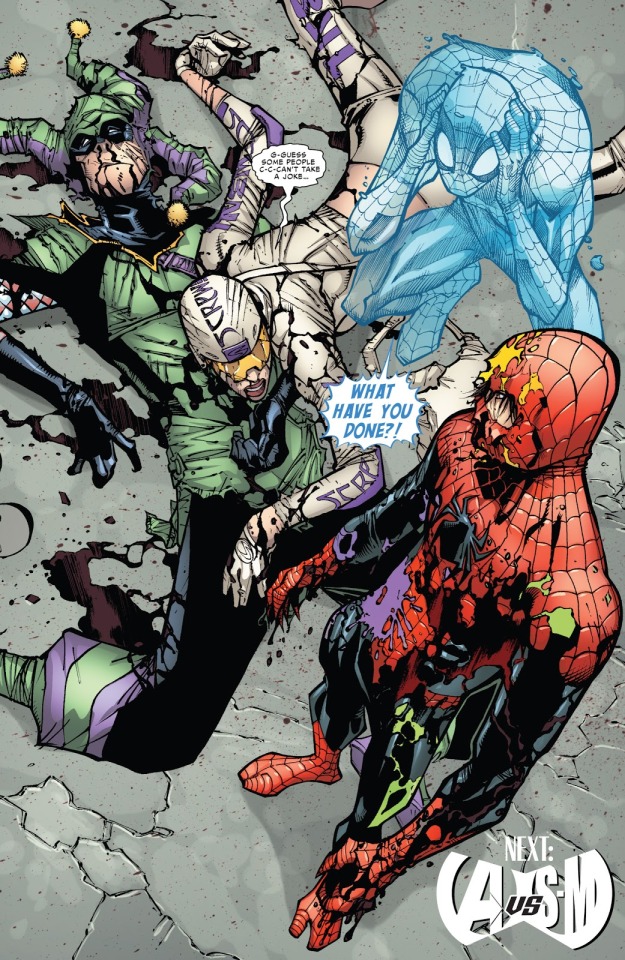
Realistically, given how horrified MJ was by the incident you’d imagine it’d stick in her mind. Additionally, given how Screwball is an attention monger and very into social media I’d imagine MJ would have some awareness of who she is. MJ herself is very up-to-date with the latest trends and would be plugged into modern pop culture and social media.
However, for the sake of argument let’s say MJ doesn’t remember Screwball at all. Let’s say she’s never heard of HERBIE or Master Matrix. Given how in the first issue she was taking note of the criminal and super powered crewmembers, wouldn’t she at least suspect these people might be shady? Wouldn’t she double-check somehow that they are legit? It all leads back to the same complaints I made between my coverage of issues #1-2. She’s not even checked that Beck is out and about legally for God’s sake!
What’s so much worse is that the story acknowledges that these hires might be shady. Beck is concerned MJ will have reservations. MJ decides to reserve judgement.
This means she doesn’t fully trust them, that she acknowledges they might be sketchy.
And her conditions for reserving judgment depend upon even shakier criteria.
How the Hell can she tell in this singular moment, when she’s barely spoken to any of them, that any of these people:
a) ‘Believe’ in the movie like she does?
Or
b) Have earnest intentions?
She’s not verified any of them are reformed or on probation. She’s got no idea what they are fully capable of or if they are on the run.
Once more she is engaging in blind faith. She is trusting the word of a super villain who’s entire skillset revolves around lying.
The final thing to take note of is the fact that the crew are actively avoiding the Savage Six; hence the new shithole location.
Um…why aren’t they just contacting the authorities or organizing protection for themselves?
SIX super villains just attacked them and want to do so again. That’s surely grounds to bring in the police or the West Coast Avengers or somebody.
Surely, MJ herself could arrange that.
Alright, maybe you could argue they want to avoid arousing suspicion because of their criminal crewmembers. But this leads back to the fact that MJ wouldn’t stand for criminals working on the movie and Beck wanted press attention for the movie anyway. In fact if a civilian like Diperna knows about the movie how do the press not? How could no one have noticed that there are super powered people and criminals working on the set?
Everyone should know that about the movie anyway, so why not bring in help from superheroes or the authorities for protection?
The answer lies in the fact that this story is incredibly half-baked and inconsistent.
I will also add that on a purely personal note I dislike 616 Screwball so just seeing her annoys me.
The next day filming has been delayed again because of bad weather. Mysterio decides they should shoot in the caves.

Filming inside some caves nearby an abandoned zoo whilst it’s raining. Seems like a health and safety nightmare doesn’t it?
If so then it’s yet more evidence of how vain and selfish Mysterio is.
Days later, we see some crewmembers intimidated by Screwball. Their conversation with her reveals she hacked someone’s private information and threatened them to deliver food to them.
MJ overhears this conversation and learns that, in order to evade the Savage Six, Screwball arranged an unmarked truck. MJ decides to solve the problem by contacting Peter and asking if he knows any teleporters in L.A.
Later, Cloak and Dagger show up and deliver food to the cast and crew.

*pinches bridge of nose again*
God, where to start with this?
So, Screwball has definitely committed a crime in the course of her role as production manager. Hacking someone’s cloud server is very much illegal and an invasion of their privacy.* Depending upon whether you believe her or the truck driver she might also have threatened the driver’s life.
Screwball admits to having done this and MJ over hears it. And yet MJ is still ‘reserving her judgment’?
I guess earnest intentions+believing in a movie>>>>>>>>>>>harming people in Mj’s book right?...
...what the fuck Williams seriously…
But the stupidity goes another level when MJ contacts Peter so she can get super powered assistance.
Let me get this straight, MJ and Beck are on board with using superheroes to deliver food to them, but not as protection for actual super villains who want to hurt them?
And MJ in particular doesn’t feel she should let Peter or other heroes know about Mysterio or his criminal crewmembers. BUT she will still contact them for a far less serious reason?
Anyone still arguing that for MJ to ask for help would be reductive to her/female characters no longer has a leg to stand on. MJ just used super heroes to solve a problem for herself. Scratch that, she asked her super hero boyfriend to solve a problem for her. And by bringing in characters like Cloak, Dagger, HERBIE and Master Matrix AMJ has arguably invited the wider Marvel universe into the story too. At which point MJ has no end of options available to her to ensure Mysterio isn’t a danger. She just isn’t using them because Leah Williams Mary Jane is not the Mary Jane we’ve known and loved. She’s this weird facsimile with all her social skills and charm but none of her deeper moral convictions.
Finally, if Beck and MJ (hypothetically) aren’t getting protection because they have crooks on staff then why bring in super heroes at all? I admit we never see what crewmembers are in Cloak and Dagger’s line of sight, so arguably MJ asked the criminal crewmembers to scram. But a hint of that would’ve been nice.
As filming inside the cave proceeds we see the Spidey actor struggling with his lines. The scene depicts ‘Spidey’ saying ‘You’ve gone too far this time, Mysterio. Now it’s personal.’ Amidst a street full of injured/dead people.
Mallorie is playing one of the injured people.

First of all, Mallorie wasn’t an actor or extra earlier in the story. But I suppose it’s not uncommon for crewmembers to have small roles in movies and with a reduced cast it’s likely she was just filling in.
More problematically, the scene is clearly depicting the fact that Mysterio has hurt (even murdered) people in his past. He’s done stuff so bad that Spider-Man, a hero, has been personally enraged by his evil acts.
This is in the movie. It’s in the script. MJ read this. MJ is seeing this recreated.
This eviscerates even the slightest remnant of deniability on MJ’s part. As I’ve argued in prior instalments, MJ SHOULD know Beck is a killer and a violent person. There was no denying that. But even if you were being wilfully ignorant or belligerently insisting only the events of this mini-series ‘counted’, the mini-series just spelled out for you that beck has seriously hurt people and that MJ knows that.
But she is still allowing him to make his vanity project. She’s still letting him walk free. She’s still chummy with him. She’s still showing no sign at all that she’s going to make Beck face justice.
On the last pages the actor playing Spider-Man quits after a light falls nearby. This leaves Beck and MJ sad, wondering how they can finish the film without Spider-Man.


I have nothing to say about this beyond a heavy light falling inside a wet cave should’ve been an obvious health and safety concern.
So, that was Amazing Mary Jane #3, quite possibly the single worst issue of the entire series thus far.
Honestly, I’m going to soldier on through this series, but I’ve made my points.
There is no hope of fixing this series now.
Not because there couldn’t be a justifiable explanation (or several) that could address all the problems. But because it’s become plain to me that Williams will not provide them to us.
Williams frankly seems like someone who understands aspects of MJ as a character. She knows how to make those aspects shine.
But there are other aspects she so fundamentally doesn’t get that it debilitates any good she might’ve done.
And more poignantly, even within the context of the story she is telling she has been incredibly inconsistent and at times downright baffling.
She either needs a better editor or she might be someone who ultimately wasn’t a good fit for this character/story.
*It’s extra bad considering several years ago in real life there was a major news story about the private photos of celebrities being hacked, perhaps the most notorious example being Jennifer Lawrence. I’m like 99% sure Leah Williams heard about that because I heard about that just from tumblr and I’m not someone who used to work in Hollywood nor do I work in the entertainment industry in any capacity.
P.S. How does Peter not know about the Savage Six?
Super villain attacks aren’t that common outside of New York city and the villains in question are predominantly associated with operating in NYC.
Three of them are very recurring enemies of his, one of which committed some very violent crimes during a traumatic recent event; the ‘Hunted’ storyline.
They attacked the set of another of his very recurrent enemies that his lover is working on.
None of this happened in a secluded location, it was all perfectly public.
So how on Earth does he not know about this? Why hasn’t he contacted MJ to ensure she’s okay? Why isn’t he riding down there to see if he can help her or trying to arrange his Avengers buddies to provide some protection?
The only answers are that MJ has lied about that again, Williams is mischaracterizing Peter indirectly or this story is badly written.
Previous Part
Next Part
Master Post
#Leah Williams#Amazing Mary Jane#mjwatsonedit#mary jane watson#Mary Jane Watson Parker#MJ Watson#Spider-Man#Peter Parker#Mysterio#Quentin Beck#Carlos Gomez#Vulture#The Vulture#Adrian Toomes
10 notes
·
View notes
Text
EVENT BATTLE 2017: DC’s DARK NIGHTS: METAL vs MARVEL’s SECRET EMPIRE
I know I said that this would be an annual thing, and I’ll try to keep this on schedule, and I’ll try to post these on time, and I know I’m posting the one for 2017 as 2018 comes to an end… but writing this took a backseat as I had to finish some projects and write a thesis. C'est la vie, as the French say.
Welcome to EVENT BATTLE 2017, ladies and gentlemen. Thank you for sticking around.
Last time we had what I called a Triple Threat Match: DC vs Marvel vs Valiant. While I was hoping this would be a trend going forward, Valiant Comics took a break from publishing big summer crossover events this year. They’ll be back for the 2018 edition of Event Battle, though. (Side note: I absolutely adore Valiant’s quality over quantity strategy, and I hope it continues despite the recent setbacks.)
So, back to the heavyweights, then?

2017 saw DC Comics handing over their universe to the most successful team off their New 52 experiment, Scott Snyder and Greg Capullo (of the Batman fame), in the form of METAL, or Dark Nights: Metal. While Metal is indeed a continuation of Snyder and Capullo’s run on Batman, it does build itself up on the shoulders of giants. Peter Milligan and Kieron Dwyer’s “Dark Knight, Dark City” being one, Grant Morrison’s seminal run on Batman, Final Crisis, his The Multiversity stuff, and pretty much the entirety of his DC output is some of the few important stories from the past that the creators wove into theirs. However, although Metal leans on and borrows from a lot of stories (like most modern superhero stories do), it does not make them a required reading. You will easily find your way if you have never read “Dark Knight, Dark City” (you should, though) and don’t know who or what Barbathos is. Metal is that accessible to new readers. If you are a long-time reader and know your comics, however, it is oddly satisfying when you catch a reference.
Like I mentioned earlier, Metal brings back Barbathos, the bat daemon occultists in 1776 (including the third President of the United States of America!) tried summoning with their “Ceremony of the Bat”. Bruce Wayne, because of his connection to both the Wayne family and, well, I guess, bats in general, is revealed to be the host for Barbathos’ return. To act as the portal/host for the daemon, Wayne needs to be exposed to five divine metals. It is revealed later that Batman already has been exposed to most of them in previous storylines (Electrum in “Court of Owls”, Dionesium in “Endgame”, Promethium in “Superheavy”, Nth Metal in the prologue of the event with Dark Nights: Casting and Dark Nights: Forge , and finally, Batmanium during the course of this story). The daemon, of course, has evil intentions. It is bringing with itself the “dark multiverse”. It literally wants to sink the Earth and flip the scales.
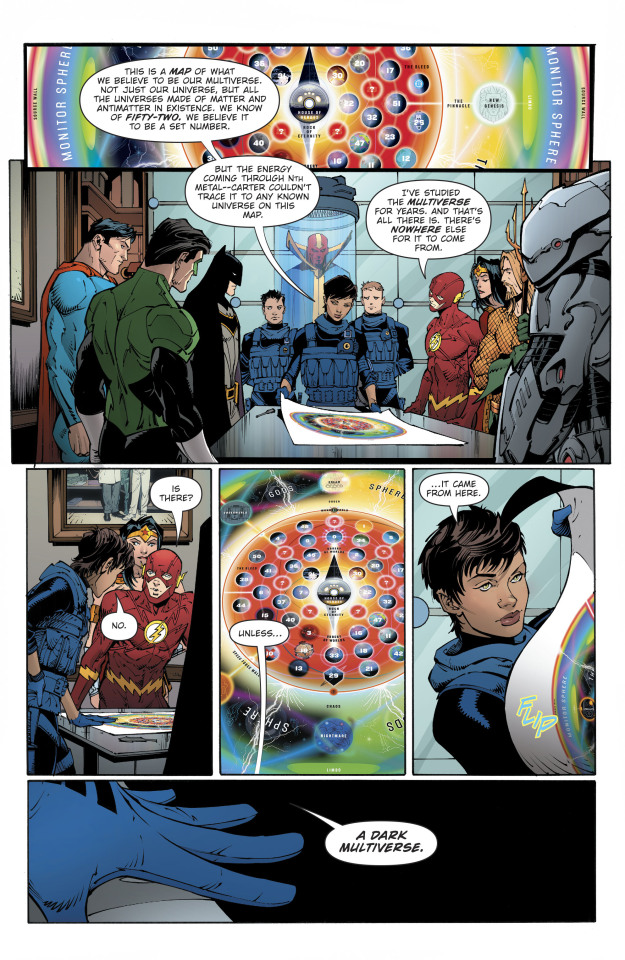
Oh, and also, it is bringing with itself the twisted versions of Batman… who kinda do look awfully similar to Dark Judges from Judge Dredd?
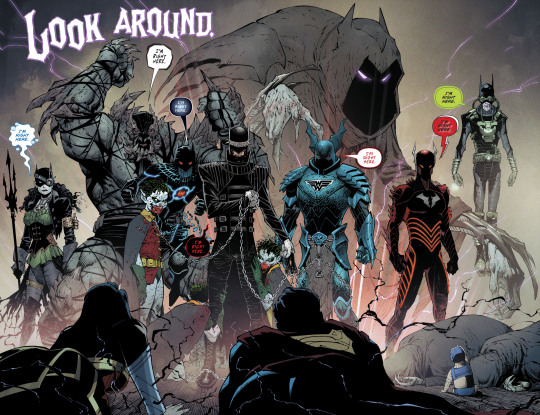
As you can imagine, much of the story then follows Batman and the Justice League’s attempt at stopping Barbathos and his horde of mercenaries. Metal is filled to the brim with ridiculously absurd and deliciously fun moments throughout. While I did stick with my rule of not reading the tie-ins for events, I did read those that Snyder co-wrote, and they work quite well with the main story. They offer details to the story as you would expect from a tie-in but if you do choose to follow the main book only, you would be good.
While bigger, louder, more ridiculous seems to Snyder’s modus operandi for every story after “Zero Year”, it just kinda works here. Rarely does the story pauses and the characters get a chance to breathe. Even the dialogues are written in such a way that they service the plot forward and not add any depth to the characters themselves. While this does seem to continue on his Justice League run, what I do appreciate here is how he managed to adapt and extend previous stories and add more layers to the cosmic side of the DC Universe, which I have always felt falls a bit short when compared to Marvel. Apart from Darkseid and the New Gods, there’s not much else to it, is there? (Cue fans telling me off in 3… 2… 1…)
Greg Capullo draws every issue of Metal, front to back. This in itself is unheard of for modern superhero crossover events, but that’s not all. The man knocks it out of the park throughout. From huge action splash pages to an eight panel page of a tightly choreographed fight scene, Capullo works his magic throughout. Joining him on the tie-ins are John Romita Jr., Andy Kubert, Jim Lee, Doug Mahnke, Yanick Paquette, Jorge Jiménez, Riley Rossmo, Howard Porter, Bryan Hitch, Mikel Janín, and a host of talented inkers and colourists. While on some scenes in the tie-ins, the transitions between the artists is not subtle and it feels a bit off, the books are a sight to behold. If Jorge Jiménez’s work on Superman, Super-Sons, etc. didn’t inform you, the guy is a superstar.

Marvel, on the other hand, had a rough year. I’m talking about the comic book side of the business, of course. They seem to be doing just fine everywhere else.
SECRET EMPIRE is the continuation of Nick Spencer’s Captain America run, specifically his ‘Hydra Cap’ storyline. You know, the one that caused so much outrage. I wasn’t following his run then, but reading this event now, I learnt that (spoiler alert:) that man is that controversial panel actually is Steve Rogers. While the story very firmly establishes that it is not an LMD, not a clone, not a shape-shifter, etc., that man is still not our Captain America. Something is a bit off – specifically, Rogers gets his history rewritten by a sentient cosmic cube – and this leads to an interesting “What If?” storyline, almost.
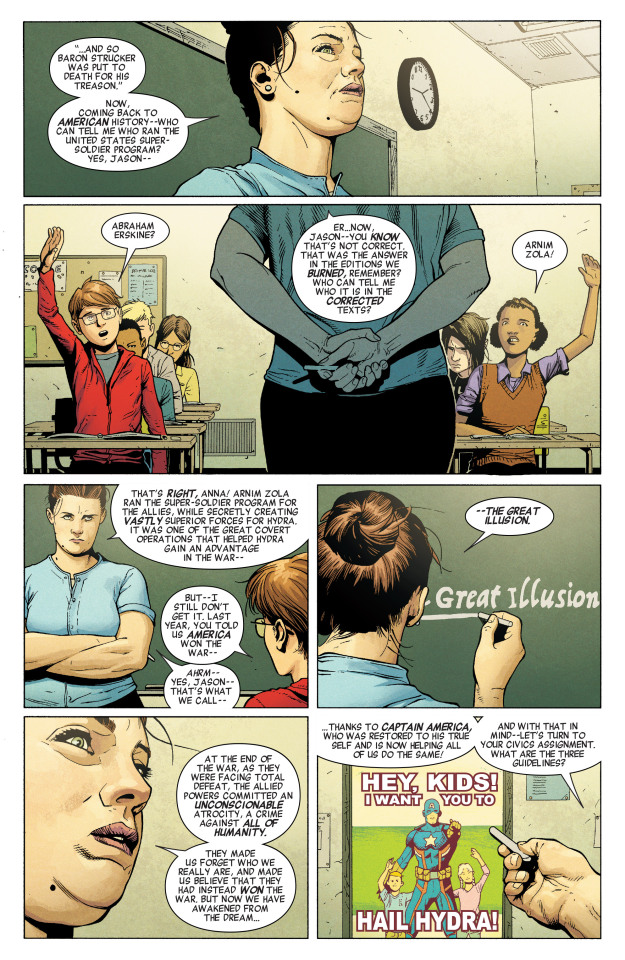
Yes, Captain America is a Hydra agent. The bad guys have won. America is under Nazi rule (Which, is not that different from the current state of things, is it?). Spencer’s plays with this idea throughout the story, drawing parallels between the two. For example, the persecution of the Inhumans in the make-believe world is drawn from the persecution of the Jews in the real, and so on. While the story is not that epic in scale as Metal perhaps is, it does work as a summer blockbuster crossover event story regardless. Spencer also smartly limits the active cast. New York is put under a blackout, so half the Marvel superheroes are off the table and a shield around Earth has locked out heavy-hitters like Captain Marvel and such. This makes it easier to follow the action. Not that I doubt Spencer’s ability to write a large cast (he does exactly that so expertly here) or that I doubt the reader’s ability to read a book with a large cast. A smaller cast works here, because unlike Metal, for example, this is not a story about the heroes trying to stop the bad guys from winning. They have won already. It is up to a handful of rebels to overthrow the regime Reich.
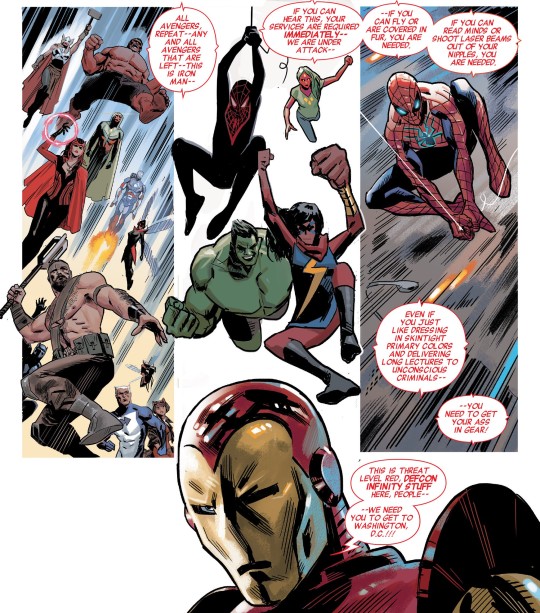
The first and the last issue of the story is drawn by Steve McNiven, and rest of the work is divided among Rod Reis, Daniel Acuña, Andrea Sorrentino, Joshua Cassara, Leinil Francis Yu, Sean Izaakse, Joe Bennett, Ron Lim, Paco Medina, …holy shit that’s a lot of artists. To their credit though, the editorial team does manage to avoid any art inconsistencies. The story follows the one artist per issue rule to the dot, or a specific artist(s) sticks with a particular plotline. Steve McNiven hyper-detailed art sets up the mood perfectly in the beginning and that exposition is perfect for the end. Andrea Sorrentino, I think, handles a major portion of the book. His panel structure and innovative use of the borders and the gutters is fantastic.

THE VERDICT
To be honest, this was the hardest it has been in quite some time to pick one of the two. Usually, I like one book over the other a lot. Infinity over Forever Evil, Original Sin over Futures End, Secret Wars over Convergence, Rebirth over Civil War II and 4001 A.D. This year, I thought both worked quite well in their own regard. Neither of them is perfect by any means. There are some gaping holes in the plot of both stories. Dream appearing in Metal to add a convenient layer of exposition to an ‘oh my god, how are they ever going to do it?’ plot, The Punisher and Thor kinda turning Nazis with little to no conviction in Secret Empire, and so on. Nonetheless, I had a good time reading them, and that’s all that matters on some days.
While both Metal and Secret Empire had some lasting impact in their respective universe, most of what was caused by Secret Empire has been hushed over. This is partially, I think, because of all the (unnecessary) outrage it caused. Metal, on the other hand, boosted sales, launched new series, spun new tales. I had so much fun reading that book. And oh, how could I ever forget baby Darkseid doing the devil’s horns?

#marvel#DC comics#event battle#metal#dark nights metal#secret empire#hydra cap#baby darkseid#scott snyder#Greg Capullo#nick spencer#steve mcniven#andrea sorrentino#rod reis#dark knight dark city#grant morrison#peter milligan
1 note
·
View note
Photo
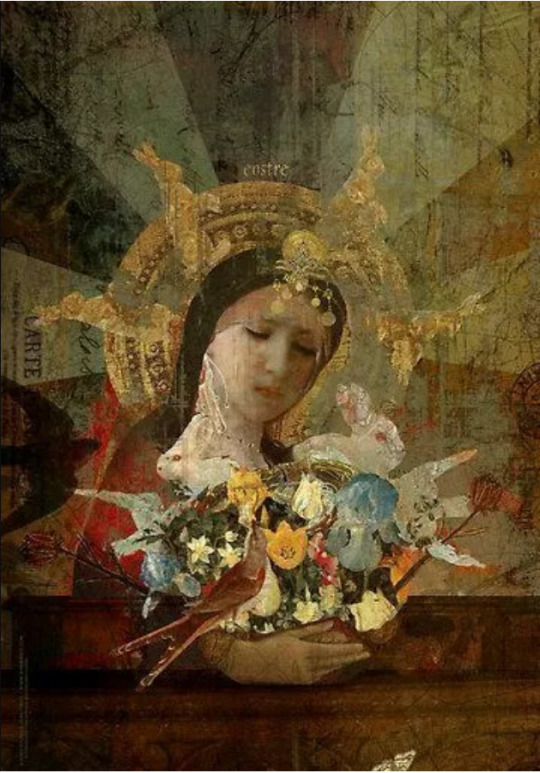

Happy Easter from the ancient Germanic goddess Eostre, and her adorable bird-turned-hare companion, who has laid colorful eggs as a symbol of fertility during a springtime festival held in the deity’s honor!
I mean, they seem lovely, I’m sure they would wish you a Happy Easter, even though there’s no substantive evidence that they were ever part of any folklore... yeah. Oof. So bite the ears off that chocolate bunny, yank off that Easter bonnet, and let’s go-a myth-busting.
To begin, I should mention three things:
First, I am a skeptic at heart, and though I was raised in a Christian household, I've been a one-foot-over-the-line-into-atheism brand of agnostic for quite some time (20-ish years), and I tell you that to tell you this: I couldn't care less about the "IT'S PAGAN!" - "NO IT'S JUDEO-CHRISTIAN!" thing. I'm just reporting the facts.
Second, what I'm not going to get into here (minus passing mentions) are where modern Easter practices have come from, nor traditions involving hares in general/beyond Easter that have been passed down through largely unconfirmed folklore.
Third, this is a very conversational write-up because my love of academia aside, good night nurse, can their articles be snoozefests. Plus, some on the religious end of the spectrum can bend preachy, then at the atheist end they can bend snotty. This strives to be neither, just aims to be a fun, informative read.
Feedback is fuel, so - as always - be it for this or anything else coming from here, let me know what you think.
- THE NON-EXISTENT GODDESS & BEDE THE B.S.’ER -
May as well kick off with the hard drop:
There is but one reference to a pagan goddess named Eostre, and its source leaves much to be desired.
An English monk called Bede wrote a book called "De temporum ratione" (“The Reckoning of Time”), in 725, and it was about this ongoing nattering amongst various Christian groups - we get to that in a sec - about when exactly Easter was, and by that I mean to say they were fussing over When did Jesus do his die-and-rise. So Bede's jam was working out a calculation for his fellow monks so this could be settled. And in doing all this, he goes to town on calendars in general.
He talked about the the traditional Old English names of the months, breaking down the etymology, and proposed that some seem to stem from agriculture cycles, such as Weodmonath ("weed month) = August, or Thrimilcemonath ("three milkings") = May. Okay. I don’t quite track with ya, Bedes, but I’m also not of 8th century stock.
Then he postulated on some he thought referred to Pagan tradition. There’s Halgemonath ("holy month) = September, for instance, Bede saying it was "a month of sacred rites” that had to do with harvest. Then he asserts two were named after goddesses: Hrethmonath = March, after Hretha, and Eostremonath = April, after Eostre. The hitch in Bede's get-a-long?
There's no references to a goddess called Eostre, like, anywhere. So what the what, Bede?!? The "what", according to some scholars, is that Bede didn't have the first damn clue as to where "Eostremonath" came from, so he made up the goddess to tie a nice little bow on his etymology fact droppage.
But fine, fine, fine - let's give the Bede-man an out, cotton to his assertion and say there was a goddess Eostre whom people honored via springtime get-togethers. Let's say her name was co-opted into English for a month of the year (wondering why Charlemagne - you know - the German dude who ended up Holy Roman emperor- would up and go with “Aprilis” when he modified the ol’ Julian calendar notwithstanding, because we’re going with Bede, here), and since it was "her" month, later got co-opted onto said month's big holiday. Great.
Revised hitch: zero evidence of anything to do with this - symbols, rituals, ceremonies, take your pick - being associated with some Eostre in Anglo-Saxon England Pagan circles. So if Eostre was super popular, enough for Christians to do the co-opting, then there should be some evidence of the source.
Christians had been doing the Easter thing since, at minimum, the second century, before they would've met these Eostre devotees in order to snitch ideas from them. Point is, Easter as a Christian celebration has been happening for about 1300 years. There's records of all of it. This Eostre chick would've come up. And the old-school historians weren't hiding some big secret about theft of concepts from pagans, and how do we know that? Because they pony up when they have. Here's an example - you've heard of the Anglo-Saxon deities Woden and Thor, yeah? Wednesday and Thursday, meet your namesakes.
And on the subject of other deities, Thor and Woden are paralleled in Germanic and proto-Christian traditions, and plenty more in other cultures (think Greek-Roman gods, how Aphrodite and Venus are essentially the same thing) with overlap like this, yet there's none for Bede's gals Eostre or Hretha.
Oh, did I not mention that? Bede probably invented the goddess Hretha, too.
Dang it, Bede!
Further down - because it's more in line with the bunny talk - I mention a dude who claimed he could kinda see a parallel with a Celt goddess, and it is such the shaky connection. Because it's based on the bizarre thing that is touted about Eostre and this bird that she turned into a rabbit. Yes, you read correctly - that’s covered below, too.
This Celt goddess Abnoba - based upon my admittedly cursory dive - is touted by numerous blogs and wikis and whatnot as a "goddess of the hunt" and, of course, being female, you know what's coming next. Throw a rock at any female deity in any culture, and any that you hit will have this on their CV: either they'll be primarily functioning as a goddess of fertility (and love and sexuality), or some/all of that'll be listed as a sub-function. What the hunting thing would have to do with Eostre/Ostara's shtick is beyond me, and the other factors, like I said, are evergreen lady godfigure traits.
Lookit, Bede wasn't exactly the best go-to for origin stories, he whiffed on other things. In his book, he says a winter shindig called Modranecht (Mōdraniht or Modranicht - Old English "Night of the Mothers" or "Mothers' Night") was called that because of "ceremonies they enacted [that] night". Well. Yeah.
Oh, Beeeeeede.
So what about Ostara? The alt version of Eostre's name? Well, a certain linguist, folklorist, and author named Jacob Grimm (yup, of those Grimms), seemed to want to believe that sneaky Bede, and he tried to find an explanation, saying in his 1835 book "Deutsche Mythologie" that maybe Eostre was some sort of local version - local to Bede, that is - of a "widespread" Germanic goddess. One whom Grimm named Ostara.
Make sure you caught that: not "who was named Ostara" or "who was called Ostara". Grimm named this mystery goddess himself. And historians can't find evidence of her, that she ever existed anywhere but in (heh) Grimm's fairy tale.
Dang it, Grimm! Stick to frightening children with mermaids, man.
To sum up: Ostara is purportedly in Germanic folklore, except she's not, at least, not anywhere but in Grimm's imagination, evidence-wise. Eostre was supposedly an Anglo-Saxon goddess, except she's not, because there's no evidence in Pagan sources, and the only Christian source she pops up in was ya boy Bede's book.
- PAGAN V. JUDEO-CHRISTIAN: TRADITIONS & MYTHS -
We touched on tradition/deity overlap a little above, but let's dig deeper. A common sentiment is that Easter was "changed" to being a Christian thing from a Pagan thing when Constantine "Christianized" the Roman Empire.
Nah.
Seems Constantine converted to Christianity in 312 and, interestingly, the next year he actually decreed there should be toleration of all religions, the point being to end the continued, albeit down to periodic, persecutions of Christians. But he didn't demand that the citizens under his rule convert - smart dude, he'd have alienated all the Pagans. Turns out, a healthy amount of the higher class folks were Pagan, and he needed their support/involvement. Granted, there were later edicts that shut down official state sponsorship of pagan cults (temples, meeting places, etc.) and public pagan ceremonies, but hey - you claim neutrality, it's gotta apply to all religious practices across the board. Well. Assuming he did the same regarding Christianity. But that's another topic.
Bottom line, the Roman Empire was not formally declared a Christian state til Theodosius, who proclaimed it as the official religion in 380. Constantine had died about 43 years prior. Still, I can possibly see where the rumor started, as Constantine seemed to be the first big-deal-figure who was open about his Christianity. And it might have also piggy-backed off of the work of the First Council of Nicea, which went down in 325. Y'know, not after he kicked the ol’ Roman situla.
Basically, the Council aimed to settle disputes happening amongst the Christian churches, and while they were at it, they ruled on when celebrations of Easter should go down (see above, RE: Bede the Balla still dealing with it in his time), as this was, it seems, A Very Big Deal.
A dude named Eusebius - historian, later bishop, straight outta Caesarea - said there had been fussing happening all the way back to 190. The bonnets were bee-heavy because they (who is "they"? "They" are always such a PITA) couldn't decide whether to make Easter a whole week, a la the Jewish Passover, or just on a Sunday, since they were convinced Jesus died on a springtime Friday, meaning the rise happened on Sunday. The west side of the Empire was doing it up on just the one day, and the east was kickin' it all week. The Council ended up going with Sundays, and said this new jam would start on the first Sunday that followed the first full moon after March 21st.
Now, a mention in one of the cited sources below notes that some attest Passover itself has roots in a pre-historic Semitic spring festival, but I'm not going down that rabbit hole (heh), knock yourselves out. Point is, Easter is related to the aforementioned vernal equinox - that full moon thing - because it coincides with Passover. It's a Judeo-Christian thing, not a rip-off of a Pagan festival thing, best historians know via the evidence.
- HARES & BUNNIES & EGGS, OH MY! -
There's no eggs or animals of the rabbit persuasion in Biblical gospel narratives, so the assumption was it must have stemmed from a Pagan tradition. You’ll see things pop up in social media feeds, images touting (some) Christians’ claims that eggs symbolize Christ's rebirth (but.... what? And why? And.... whatever). There's evidence of medieval Christians decorating eggs and then eating them at Easter, and that actually might have a logical reason, at least, beyond folks of Ukrainian descent carrying on a tradition past generations might’ve carried over when migrating (more on that below).
Many religions across the board have guidelines - for some, heavy rules - surrounding fasting for lots of reasons (look it up yourself), and some of those are part of festivals and such throughout the liturgical calendar (a.k.a. - designated times for public community celebrations). In the evidence pile for Easter, there's a "festal letter" from this guy Athanasius in 330 who talks about a 40-day fast that ended on Easter Sunday. I'd like to point out here that this happened post-Nicean council decree, keep that in mind.
Why this is possibly of import is it turns out, Constantine had exiled Athanasius for being mouthy about grain or something, and he booked it back to Alexandria after Connie bit the dust.... only to be exiled again the next year when Connie, Jr. - Constanius - found out. But Athanasius was apparently a charmer, and knew how to take advantage of a situation, so he ends up in Rome under the protection of Connie's other son, Constans - ah, so I guess Connie, Jr.: The Sequel - who was emperor in the west. You know, the west, the crew who liked making Easter a one day throw-down vs. drawing it out. I would be delighted to learn that Athanasius was trying to get everybody on board with a long celebration just to shoot a post-mortem bird at Constantine. Atty-boy ended up being made a saint, so aside from that grain kerfuffle, appears he was a popular guy, had a "flock" as it were, which is how historians have all the Festal Letters, including ones talking about the date(s) of Easter parties and this fast.
And, again, "fast" can mean a variety of things - total abstaining, sure, but even Jesus would give you side-eye over 40 days of nothing, you ain't rising from anything after that - but lots of times it was just cutting out certain things, food or otherwise (hello, Lent). And many of those are specifically about food from animals, so there's meat, to be sure, but in addition to that, the products of animals, meaning milk, cheese, butter, and - say it with me, now - eggs.
No refrigerators means lots of wasted food, so the people had to eat up what they had and - duh - not slaughter for meat, don't milk the cows/goats, and don't make any butter or cheese. Easy. But chickens don't give a rat's ass about calendars and religion, they're gonna keep cranking out the goods and, again, not eating them in real time means a 40 day sulfur cloud looming over the area. Reason dictates they boiled them, problem solved. I mean, I wouldn’t crack open a month-old boiled egg, but folks of the before-years-had-four-integers variety had bellies that could handle a lot of things that would have us hugging porcelain thrones for weeks. That’s another discussion, one I cannot promise we’ll ever have.
It took a bazillion years to make cheese, and butter was no quick work, and neither was curing meat (look it up) - those wouldn't be ready for Sunday. And sure, you could pop out and milk something, lay waste to some cow for fresh steaks, but hell - to cover everybody, you'd have to knock off more than one. Way more than one, probably to the detriment of the sustainability of a mini-herd on a given family farm. Realistically, most of the feast would be any nasty, salted-out jerky somebody had leftover from pre-fast, more veg and fish and bread, which would all suck - but wait. WAIT. Eggs.
Cock-a-darn-diggly-doodle-doo.
So, in the week before Easter, they'd have been boiling like crazy, one would think, as part of the prep for the major gullet-stuffing coming up that Sunday. There's references to the eggs getting glammed up to be extra festive at least as early as the 13th century, and I suppose it's not a stretch to say they were beyond happy to have at least one of their food options back on deck and wanted to make things extra special - you can’t really glitter up fish and potatoes, after all. In any event, the fast-related thing is the most logical regarding Easter-egg association, and as I mentioned, maybe a touch of family tradition, which brings me to the next part:
Wabbit season.
There's another book called "Deutsche Mythologie", from 1874, and the author, Adolf Holtzmann, talked about the German Easter hare - which, historians are certain of, is where the Easter bunny comes from - and speculated on its possible source. What he suggested is reportedly the first documented instance of a certain somebody, perhaps you've heard of her, spoiler alert: it's Ostara.
"The Easter Hare is inexplicable to to me, but probably the hare was the sacred animal of Ostara; just as there is a hare on the statue of [the Celtic goddess] Abnoba.”
We covered that random Abnoba comment above, but.... Adolf....what? So how did rabbits get hooked up to Ostara? And what’s up with the hare laying eggs?
By the way, the hare must once have been a bird, because it lays eggs....
Well, sure, of course.
The essence of the current party line is that Ostara transformed a bird into a hare, and because it was once a bird, it retained its ability to lay eggs and to thank Osara for what she’d done - no clue why she did it, but if hare’s cool, I’m cool - it laid a bunch of colored eggs to spruce up her festival.
Fine. Moving forward. In 1883, a book by one K. A. Oberle hit the shelves - and if you speak 19th century German, wanna check out the original, godspeed - and he got super specific:
Some time ago the question was raised how it came that, according to South German still prevailing folk-lore, the Hare is believed by children to lay the Easter-eggs. I venture now to offer a probable answer to it. Originally the hare seems to have been a bird which the ancient Teutonic goddess Ostara (the Anglo-Saxon Eàstre or Eostre, as Bede calls her) transformed into a quadruped. For this reason the Hare, in grateful recollection of its former quality as bird and swift messenger of the Spring-Goddess, is able to lay eggs on her festival at Easter-time
As specific as that was? No specific sourcing. Minor shout-out to Bede, though. And there was a mention of a general source.... Holtzmann.
Great.
Shifting gears - but stay with me - to way-back-when in the Ukraine. They had a folk tale about the origins of pysanka, a.k.a. "painted eggs", but that definition is actually incorrect. Pysanka are not painted, they're "written on" via a beeswax-dyeing technique. They are absolutely stunning - the side of my family with Eastern European roots blessed us of the newer gen by passing down Christmas ornaments fashioned in this style, and they are my favorites. Here's a random google image of some of these works of art:

The wikipedia article on the history of pysanka has some decent citations, so I’m comfortable using it as a source. The Reader’s Digest version for their existence - based on passed-down folktales and analyzation done of symbols on what archaeological samples have been found - back in the pre-Christian era was warding off evil to keep the world going, keep nature growing, the ongoing “rebirth” of plants and animals, make the sun deity happy.
Because of that sun deity element - if it’s correct, because, again, brittle eggshells and faded symbols call for educated guesses vs. hard truths - of the pysanka thing, an argument could be made that it should be filed under Pagan. Then because the Eostre thing is touted as Pagan, and because nature springs back to life from winter in, well, spring, and (I’m assuming) because rabbits mate like their tails are on fire, the whole shebang was rolled into this big, fantastic ball of nature-goddess-bunny-rabbit-spring-equinox-pretty-eggs untruth.
Christians have melded stuff and mutated folktales and cultural traditions to suit their religion, no doubt, and I could write multiple articles on things Christians claim as fact that have no evidentiary basis; it just seems like here, as time rolled on, this is something that Pagans got duped by when legends - and some outright lies - got pushed as indisputable fact.
And as far as untruths go, this seems minor. It’s fun to guess at things, make up our own headcanon, but if we’ve got facts? If those facts disprove something we may have our hearts set on believing? Well, accepting them is part of being a grown-up. Which sucks. But here we are.
Besides, who cares, truly? Is this Easter customs thing really important? Isn’t the time spent with family and friends and people in your community what’s most important? Hell, be like Bede & Co.: make your own traditions. And anyway, SO MUCH CANDY is gonna be on sale tomorrow. #hail Eostre #goddess of chocolate bunnies #whose delicious ears #I shall happily chomp
We'll close with my favorite quote from my research:
"Some still claim Eostre's name is the root of the word oestrogen, ignoring that human eggs are microscopic and that the real etymology of oestrogen in fact relates to the gadfly."
Bet you didn't think this Easter tale would conclude with estrogen and gadflies, and yet, I can think of no stranger point upon which to end this convoluted tale.
Happy Hippity-Hops to you all!
------ SOURCES -------
Eleanor Parker - “Some Anglo-Saxon Easter Customs”
Tim O'Neill - “Easter, Ishtar, Eostre and Eggs”
Adrian Bott - “The Modern Myth of the Easter Bunny”
Steven Winick -
“Ostara and the Hare: Not Ancient, but Not As Modern As Some Skeptics Think”
“On the Bunny Trail: In Search of the Easter Bunny”
“Here Comes Peter Cottontail: Some Cultural History”
H/T Tom Holland
Images:
Silas Toball (left) & Sophie Gardiner (right)
Note:
All of these sources are robust and wonderful, however most of them are what I'd label "dense". The exception is the brief article by Mr. Bott, should you want an even more concise round-up than what I've presented here. Yes, compared to what’s linked, hand-to-Cadbury, my article was concise.
Should you want an A/V roundup, in 2016, Mr. Winick was featured in a segment on the (US show) CBS Sunday Morning, called "The Real Story of the Easter Bunny", and Eostre is discussed as well. [You can stop around the 2:50 mark, as from there they go on to discuss rabbits in general]
There are also additional sources referenced and/or linked in every citation above, should you want more clarification on their assertions.
#GENERIC#EASTER#EOSTRE#OSTARA#MYTHOLOGY#FOLKLORE#PAGAN#GODDESS#SPRING#SPRINGTIME#RABBIT#HARE#EGGS#FESTIVAL#FERTILITY#MYTH#ANGLO-SAXON#GERMANIC#MYTH BUSTING#HISTORICAL#EVIDENCE#BEBE#GRIMM#NASH REPORTS
13 notes
·
View notes
Text
Are Christianity and Buddhism the Same? - G. K. Chesterton
Oftentimes Chesterton had something to say about Buddhism. This was one of those times. From the book, Orthodoxy.

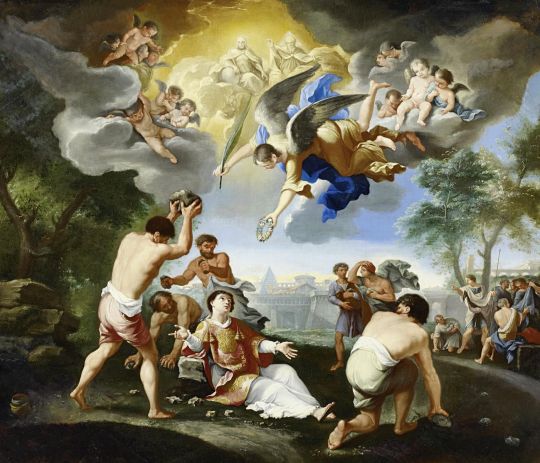
The great example of this alleged identity of all human religions is the alleged spiritual identity of Buddhism and Christianity. Those who adopt this theory generally avoid the ethics of most other creeds, except, indeed, Confucianism, which they like because it is not a creed. But they are cautious in their praises of Mahommedanism, generally confining themselves to imposing its morality only upon the refreshment of the lower classes. They seldom suggest the Mahommedan view of marriage (for which there is a great deal to be said), and towards Thugs and fetish worshippers their attitude may even be called cold. But in the case of the great religion of Gautama they feel sincerely a similarity.
Students of popular science, like Mr. Blatchford, are always insisting that Christianity and Buddhism are very much alike, especially Buddhism. This is generally believed, and I believed it myself until I read a book giving the reasons for it. The reasons were of two kinds: resemblances that meant nothing because they were common to all humanity, and resemblances which were not resemblances at all. The author solemnly explained that the two creeds were alike in things in which all creeds are alike, or else he described them as alike in some point in which they are quite obviously different.
Thus, as a case of the first class, he said that both Christ and Buddha were called by the divine voice coming out of the sky, as if you would expect the divine voice to come out of the coal-cellar. Or, again, it was gravely urged that these two Eastern teachers, by a singular coincidence, both had to do with the washing of feet. You might as well say that it was a remarkable coincidence that they both had feet to wash.
And the other class of similarities were those which simply were not similar. Thus this reconciler of the two religions draws earnest attention to the fact that at certain religious feasts the robe of the Lama is rent in pieces out of respect, and the remnants highly valued. But this is the reverse of a resemblance, for the garments of Christ were not rent in pieces out of respect, but out of derision; and the remnants were not highly valued except for what they would fetch in the rag shops. It is rather like alluding to the obvious connection between the two ceremonies of the sword: when it taps a man's shoulder, and when it cuts off his head. It is not at all similar for the man. These scraps of puerile pedantry would indeed matter little if it were not also true that the alleged philosophical resemblances are also of these two kinds, either proving too much or not proving anything.
That Buddhism approves of mercy or of self-restraint is not to say that it is specially like Christianity; it is only to say that it is not utterly unlike all human existence. Buddhists disapprove in theory of cruelty or excess because all sane human beings disapprove in theory of cruelty or excess. But to say that Buddhism and Christianity give the same philosophy of these things is simply false. All humanity does agree that we are in a net of sin. Most of humanity agrees that there is some way out. But as to what is the way out, I do not think that there are two institutions in the universe which contradict each other so flatly as Buddhism and Christianity.
Even when I thought, with most other well-informed, though unscholarly, people, that Buddhism and Christianity were alike, there was one thing about them that always perplexed me; I mean the startling difference in their type of religious art. I do not mean in its technical style of representation, but in the things that it was manifestly meant to represent. No two ideals could be more opposite than a Christian saint in a Gothic cathedral and a Buddhist saint in a Chinese temple. The opposition exists at every point; but perhaps the shortest statement of it is that the Buddhist saint always has his eyes shut, while the Christian saint always has them very wide open. The Buddhist saint has a sleek and harmonious body, but his eyes are heavy and sealed with sleep. The mediaeval saint's body is wasted to its crazy bones, but his eyes are frightfully alive.
There cannot be any real community of spirit between forces that produced symbols so different as that. Granted that both images are extravagances, are perversions of the pure creed, it must be a real divergence which could produce such opposite extravagances. The Buddhist is looking with a peculiar intentness inwards. The Christian is staring with a frantic intentness outwards. If we follow that clue steadily we shall find some interesting things.
A short time ago Mrs. Besant, in an interesting essay, announced that there was only one religion in the world, that all faiths were only versions or perversions of it, and that she was quite prepared to say what it was. According to Mrs. Besant this universal Church is simply the universal self. It is the doctrine that we are really all one person; that there are no real walls of individuality between man and man. If I may put it so, she does not tell us to love our neighbours; she tells us to be our neighbours. That is Mrs. Besant's thoughtful and suggestive description of the religion in which all men must find themselves in agreement. And I never heard of any suggestion in my life with which I more violently disagree.
I want to love my neighbour not because he is I, but precisely because he is not I. I want to adore the world, not as one likes a looking-glass, because it is one's self, but as one loves a woman, because she is entirely different. If souls are separate love is possible. If souls are united love is obviously impossible. A man may be said loosely to love himself, but he can hardly fall in love with himself, or, if he does, it must be a monotonous courtship. If the world is full of real selves, they can be really unselfish selves. But upon Mrs. Besant's principle the whole cosmos is only one enormously selfish person.
It is just here that Buddhism is on the side of modern pantheism and immanence. And it is just here that Christianity is on the side of humanity and liberty and love. Love desires personality; therefore love desires division. It is the instinct of Christianity to be glad that God has broken the universe into little pieces, because they are living pieces. It is her instinct to say "little children love one another" rather than to tell one large person to love himself. This is the intellectual abyss between Buddhism and Christianity; that for the Buddhist or Theosophist personality is the fall of man, for the Christian it is the purpose of God, the whole point of his cosmic idea.
The world-soul of the Theosophists asks man to love it only in order that man may throw himself into it. But the divine centre of Christianity actually threw man out of it in order that he might love it. The oriental deity is like a giant who should have lost his leg or hand and be always seeking to find it; but the Christian power is like some giant who in a strange generosity should cut off his right hand, so that it might of its own accord shake hands with him.
We come back to the same tireless note touching the nature of Christianity; all modern philosophies are chains which connect and fetter; Christianity is a sword which separates and sets free. No other philosophy makes God actually rejoice in the separation of the universe into living souls. But according to orthodox Christianity this separation between God and man is sacred, because this is eternal. That a man may love God it is necessary that there should be not only a God to be loved, but a man to love him.
All those vague theosophical minds for whom the universe is an immense melting-pot are exactly the minds which shrink instinctively from that earthquake saying of our Gospels, which declare that the Son of God came not with peace but with a sundering sword. The saying rings entirely true even considered as what it obviously is; the statement that any man who preaches real love is bound to beget hate. It is as true of democratic fraternity as a divine love; sham love ends in compromise and common philosophy; but real love has always ended in bloodshed.
Yet there is another and yet more awful truth behind the obvious meaning of this utterance of our Lord. According to Himself the Son was a sword separating brother and brother that they should for an aeon hate each other. But the Father also was a sword, which in the black beginning separated brother and brother, so that they should love each other at last.
This is the meaning of that almost insane happiness in the eyes of the mediaeval saint in the picture. This is the meaning of the sealed eyes of the superb Buddhist image. The Christian saint is happy because he has verily been cut off from the world; he is separate from things and is staring at them in astonishment. But why should the Buddhist saint be astonished at things?-- since there is really only one thing, and that being impersonal can hardly be astonished at itself.
There have been many pantheist poems suggesting wonder, but no really successful ones. The pantheist cannot wonder, for he cannot praise God or praise anything as really distinct from himself. Our immediate business here, however, is with the effect of this Christian admiration (which strikes outwards, towards a deity distinct from the worshipper) upon the general need for ethical activity and social reform. And surely its effect is sufficiently obvious. There is no real possibility of getting out of pantheism, any special impulse to moral action. For pantheism implies in its nature that one thing is as good as another; whereas action implies in its nature that one thing is greatly preferable to another.
2 notes
·
View notes
Text
I am TIRED of this website talking 24/7 about Shakespeare let’s talk about something else like Cervantes... like GOD Don Quijote is comedy gold. Sancho Panza’s sayings? The fact that he goes drunk on Respect Women Juice defending Dulcinea and getting his ass kicked by random people? Imagining magic windmills and fighting sheep (and getting his ass kicked by shepherds)? All hilarious. Give me headcanons about the priest and the barber who always followed Don Quijote and tried to stop him into getting in more bullshit or historical analysis about that time Cervantes was so incensed by a fanfic writer he wrote an entire sequel why let English speakers have all the fun Spanish classics are fun too
#granted I read a more modern version because the actual book is quite heavy#it's still hilarious and very smart#don quijote#don quixote#Argentine classics are good but more dramatic#so I don't think a José Hernández fandom would work so well#spanish#español
583 notes
·
View notes